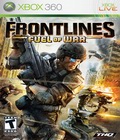Genre: First-Person Shooter
Publisher: THQ
Developer: Kaos Studios
Release Date: February 25, 2008
If you're a first-person shooter fan, you're in heaven on the Xbox 360, with everything from the heavily customizable Halo 3 and Call of Duty 4 to the more plot-oriented, single-player experiences like Bioshock. However, one kind of FPS on the 360 has been sadly ignored: team-based gameplay. Most first-person shooters on the Xbox 360 incorporate some kind of team gameplay, but titles are rarely built around it. The few games that have attempted this are either quite old, such as Battlefield 2, or rather lackluster, like Shadowrun. There's no problem with having a good game of Capture the Flag or Base Capture in Halo 3, but there is functionally very little difference between the various Spartans, aside from what their armor looks like and which weapon they're using. Thankfully, Kaos Studios, developer of the excellent Desert Combat mod for Battlefield 1942, spotted this much-neglected niche and has worked to fill it with Frontlines: Fuel of War.
The world of Frontlines is set in the not-too-distant future. The various nations of the world have either met with collapse and recession or banded together into the Western Coalition, a future organization made up of the United States and Canada and many European countries, and the Red Star Alliance, comprised of China, Russia and their vassal states. The primary focus of these two nations is power — as in the simple energy needed to keep their vehicles running and their lights on. Oil supplies have become dangerously low, and the new solar energy farms are straining to keep up with ever-increasing consumption.
Since things are in the near future, expect to see a lot of familiar-yet-unfamiliar technology. Every single weapon and vehicle in Frontlines is some sort of evolution or descendant of modern technology, be it the newest model of the XM-8 machine gun or a tank equipped with technology that is being developed even as we speak. It's a nice break from the common FPS trinity of World War II-era weapons, modern-day super weapons or far-futuristic Aliens clones.
Combat in Frontlines: Fuel of War is built around … well, front lines. Both sides are fighting over a series of choke points on the map. Capture those points, and you advance the front line closer to your enemy, giving you additional spawn locations and forcing the enemy into a smaller area. Capturing is simply done by remaining near a capture point for a certain period of time, and the more allies you have nearby, the faster the capture occurs. Capture them all, and the battlefield is yours. Players also can also win by having the most territory when the match time runs out, or forcing the enemy to expend all of their respawn tickets. It's a fairly simple system, and anyone who's ever played a first-person shooter will probably recognize the basic system of base capture. The fun is in pushing the front line back and forth in an attempt to weaken your enemy while keeping up your own strength, and it really encourages the teamwork that plays into every element of Frontlines.
At the start of every multiplayer match, players choose a loadout and a role. Loadout is your weapon selection and ranges from Assault, which includes a grenade launcher and low-powered machine rifle; to Anti-Vehicular, which comes equipped with a rocket launcher and a pistol; to the Covert Ops, which is trap-based and includes remote-detonated C4 and a mini Uzi. You can mix and match your loadout components, so initially, it seems sort of frustrating to be limited in your weapon selection, but the loadouts play directly to Frontlines' focus on team play. If every player could have a rocket launcher and machine gun or sniper rifle at the same time, it would blunt the feel of each team member having a specific purpose. As a result, assuming you're willing to work with your squadron, the loadouts end up being quite fun, although gamers who want to blast everything in sight may find the restriction frustrating instead of fun.
Each player also can select one of four different combat roles to take on the battlefield: Air Support, Drone Tech, EMP and Ground Support. Air Support allows players to call in artillery fire from far-off locations, while Drone Tech lets players control one of a few remote-controlled robot drones that can do everything from serve as homing bombs to fully armed attack helicopters. The downside is that while the player's attention is focused on the drone, his or her player is completely vulnerable to any enemies who walk by. EMP is built around disabling vehicles, and it allows players to drop EMP generators that can scramble minimaps, disable radios or stop vehicles in their tracks. Ground Support is more of an assistance role that allows players to repair vehicles and place mobile turrets and railguns.
Much like an RPG, your role earns experience points for every successful kill or capture you make. Earn enough, and you level up and get a new ability, such as an automated sentry gun or a powerful EMP device that knocks out all vehicles in a wide radius. Furthermore, roles function on a recharge system, so each use of a role's ability causes players to wait until their power recharges before they can use it again. It's a surprisingly effective method, since it both encourages players to use their role abilities freely without fear of searching for a recharge, and it limits them enough so that good gamers will have to master using their loadouts as well as their roles. Perhaps the only downside to the roles is that unlike current fan favorite Call of Duty 4, experience does not hold between games. If you've leveled a Drone Tech up to level three in a prior game, you have to do it again in a new game. It's only a small problem, but it can be a bit aggravating when you get to the top level, only for the game to end a few moments later.
One of the other frustrating elements of Frontlines: Fuel of War involved the game's vehicles. The vehicles themselves are well designed, with each machine having its own unique set of abilities. Western Coalition machines, for example, tend to be more technologically advanced and have varied weapons and special features such as stealth. On the other side of the coin, Red Star followed the popular AK-47 theory of no frills but great durability. Their machines are dirtier and more rugged but tend to pack a greater punch and have more armor. Much like the differences between the various roles, the different vehicles really helped set apart the Red Star and Western Coalition forces. The problem is in the vehicles' controls: While most of the machines controlled just fine, I found myself getting slow or stiff responses from some, especially the jets, which seemed to take almost a second to respond to every action I made. Once I adjusted to the lag, I was able to control the machine fairly well, but it never felt quite as smooth or natural as on-foot gameplay.
More than your loadout or your role, the most important weapon in your Frontlines arsenal is your squadron. Once you're on the battlefield, you and a group of other players can form a squad at the push of a button. Squad members can see each other anywhere on the map and communicate with one another using a headset, which is absolutely crucial for coordinating your various loadouts and roles into an effective fighting force. Most valuable, however, is the squad leader, who has a couple of special abilities that can turn the course of battle. He or she can place waypoints for the other squad members to see, which allow even easier coordination between players, and invite new members to the squad.
Each squad leader also serves as a mobile spawn point for others member of their squad, so if your character dies at any point, he or she can respawn directly at the squad leader's location to get right back into the action. Furthermore, if the squad leader is in a vehicle, your character will instantly spawn in an empty seat in the vehicle if one exists. It's a surprisingly neat feature and not only helps to encourage teamwork, but it also keeps the game flowing at a rapid pace. As long as you're in a team, you're never too far away from the action. The one minor issue I had with the mobile spawn point is how it functions if the squad leader is in a full vehicle. If this occurs, it becomes impossible to use the squad leader to spawn, which either discourages the use of vehicles or prevents players from hopping back into the action as quickly as they should. Luckily, unless your squad leader is the kind of fellow who hops right into a tank at every opportunity, this is a rare problem that can be a little annoying.
Teamwork is incredibly important in Frontlines: Fuel of War. Every single element of the game is absolutely mired in working with other players to succeed. Loadouts and roles may have their advantages and disadvantages, but they won't function well without a fellow ally to assist you. Someone with a rocket launcher and drones is not going to survive for long unless he receives backup from an ally who is better equipped for taking out nonvehicular threats and fast-moving enemies. Likewise, piloting a vehicle alone is simply asking for trouble. They're difficult enough to pilot when you only have to focus on driving, but trying to switch between driving and gunning while under fire from every direction is a quick way to get your character killed. Unlike many recent FPSes, no man in Frontlines: Fuel of War is an army. Joining up with a squad and balancing each other's strengths and weaknesses is absolutely crucial to victory. It's a refreshing change from titles in which "teamwork" simply means that more bullets fly toward the enemy, or occasionally driving a Warthog while your ally holds the flag. In Frontlines, if you're not a member of a team, you're fighting at a severe disadvantage.


The focus in Frontlines is undoubtedly on the game's multiplayer mode, but rather refreshingly, it also has a surprisingly effective single-player mode. Many recent online-focused games, such as Microsoft Studios' Shadowrun, limited their offline content to simplistic tutorials. The single-player mode in Frontlines serves as a half-tutorial/half-game that works surprisingly well in being an enjoyable single-player experience and preparing gamers for online play. The single-player mode throws gamers into the shoes of one of the Stray Dog Squadron, a Western Coalition elite force that finds itself on the front line of the Red Star's push to dominate the world's dwindling oil supplies. The story isn't going to win any Oscars, but it is a fairly interesting and surprisingly chilling story, mostly for its realism. Everything in the future world of Frontlines: Fuel of War is a natural evolution of the current problems we're facing in the world today. It tells an interesting story not because of deep plot twists or spectacular characters, but because it offers a glimpse into an all-too-possible future, a place rarely explored by shooters that don't include the words "Tom Clancy" in the title.
Frontlines' single-player campaign doesn't feature the loadouts and roles featured in the multiplayer mode. Instead, the player is free to pick up and use various weapons and items found around the level. However, each level introduces you to the items you'll find in the multiplayer loadouts and encourages you to learn how to use each one. Since you can use any weapon, item or vehicle, you'll quickly become familiar with both Red Star and Coalition armaments. By the time you finish the single-player campaign, you'll be able to jump right into the multiplayer mode and recognize exactly where you need to go and what you need to do. While the single-player campaign is quite fun and a good tutorial, it isn't going to compare to Call of Duty 4. The focus in Frontlines: Fuel of War is online play, and gamers only seeking a single-player experience will want to look elsewhere.
One area where Frontlines: Fuel of War particularly shines is the level design. In the single-player and multiplayer campaigns, most levels have rather unique and memorable designs. My favorite level was probably the multiplayer stage Gnaw, which takes place in the crumbling ruined cityscape with a number of hidey-holes and unique tactical opportunities. The engine ran these areas quite well, even in the massive 30+ player matches, with a minimum of popup. Overall, Frontlines: Fuel of War is quite a good-looking game, although it isn't going to blow your mind. It puts the Unreal 3 Engine to good use and combines it with quality art design to form a surprisingly effective glimpse into the future world. There were a few minor aggravations, but they were few and far between. For example, even in the largest stage, it was a challenge to fly the jet without encountering the level boundaries, partially due to the stiff controls mentioned above. That is one of the few complaints that one can make about the level design, though, and Frontline provides an overall quality experience.
Frontlines: Fuel of War is a fun game. It isn't going to revolutionize the industry or displace Call of Duty 4 as the most-played game on Xbox Live, but it will provide a fun and satisfying online experience. Gamers who are tired of being one-man armies and want to play in a more team-based environment will find that Frontlines: Fuel of War is exactly what they've been seeking. Likewise, if you enjoyed the Battlefield titles or are simply searching for something to give you a break from constant Slayer matches, Frontlines: Fuel of War will provide you with a solid and enjoyable gameplay experience.
Score: 8.2/10
More articles about Frontlines: Fuel of War












 Set in a fictional future based upon the headlines of today, F.O.W. brings players into the worlds next great war. As society succumbs to a worldwide energy crisis, a new global depression takes hold. Amidst this desperate backdrop, two superpower alliances emerge. Join the battle on the frontlines of tomorrow as the Western Coalition or the Red Star Alliance.
Set in a fictional future based upon the headlines of today, F.O.W. brings players into the worlds next great war. As society succumbs to a worldwide energy crisis, a new global depression takes hold. Amidst this desperate backdrop, two superpower alliances emerge. Join the battle on the frontlines of tomorrow as the Western Coalition or the Red Star Alliance.






































